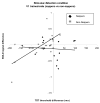Perceptual deterioration is reflected in the neural response: fMRI study of nappers and non-nappers
- PMID: 18773731
- PMCID: PMC2716730
- DOI: 10.1068/p5998
Perceptual deterioration is reflected in the neural response: fMRI study of nappers and non-nappers
Abstract
Repeated training on a perceptual task can result in performance deterioration. In the case of vision, this practice-dependent decrease, or perceptual deterioration is restored by changing the target orientation, spatial location, or by taking a daytime nap. Behavioral studies suggest the locus of these performance changes to be primary visual cortex. We used fMRI to directly probe whether perceptual deterioration and nap-dependent maintenance of performance can be detected at the level of primary visual cortex. We also asked whether these changes are due to a bottom-up, stimulus-driven response or a top-down plasticity of attentional mechanisms. Subjects were scanned while performing a texture-discrimination task. Half the subjects took a nap between sessions. We measured the relationship between changes in performance and changes in BOLD signal modulation between the two groups. Non-nappers showed performance deterioration that was significantly correlated with decreased BOLD signal modulation, exclusively in area V1 and limited to the bottom-up condition. In contrast, no change was detected in performance and BOLD response in the two conditions for nappers. These results indicate that napping prevented performance deterioration, which was reflected in the fMRI response of neurons in V1. Without a nap, perceptual deterioration was related to decreases in the stimulus-driven, bottom-up representation, rather than decreases in attentional modulation to the stimulus.
Figures





References
-
- Ahissar M, Hochstein S. The reverse hierarchy theory of visual perceptual learning. Trends Cogn Sci. 2004;8(10):457–64. - PubMed
-
- Bara-Jimenez W, Catalan MJ, et al. Abnormal somatosensory homunculus in dystonia of the hand. Ann Neurol. 1998;44(5):828–31. - PubMed
-
- Censor N, Karni A, Sagi D. A link between perceptual learning, adaptation and sleep. Vision Research. 2006;(46):4071–74. - PubMed
-
- Crick F, Koch C. Are we aware of neural activity in primary visual cortex? Nature. 1995;375(6527):121–3. - PubMed
-
- Crick F, Koch C. A framework for consciousness. Nat Neurosci. 2003;6(2):119–26. - PubMed
Publication types
MeSH terms
Grants and funding
LinkOut - more resources
Full Text Sources
Research Materials

